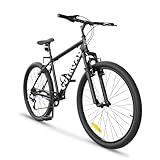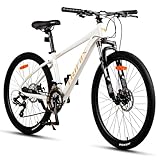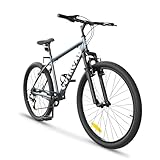If you’re a fan of off-road cycling, then you’ll find that a hardtail mountain bike is a reliable and sturdy ride that can tackle any terrain. And if you’re looking for the best 26 inch hardtail mountain bikes, then you’ve come to the right place. In this article, we’ll take a look at the top 10 best 26 inch hardtail mountain bikes that are currently available in the market, along with a comprehensive buying guide to help you make an informed decision. So, whether you’re a novice cyclist or an experienced adventurer, read on to find the perfect 26-inch hardtail mountain bike to suit your needs.
Get ready for our reviews on the best 26 inch hardtail mountain bikes, but first, here are some related Amazon products to check out:
Last update on 2025-11-03 at 14:40 / Paid links / Images from Amazon Product Advertising API
Best 26 Inch Hardtail Mountain Bikes
26 Inch Hardtail Mountain Bikes: A Beginner’s Overview
26 Inch Hardtail Mountain Bikes are a popular choice for riders who are looking for a budget-friendly yet high-performance mountain bike. These bikes are designed with a front suspension fork that absorbs the shock and helps to smoothen out the ride, especially when riding on rough terrain. The 26-inch wheels offer exceptional traction, acceleration, and maneuverability, making it easy to navigate through technical terrains.
One of the main benefits of 26 Inch Hardtail Mountain Bikes is their versatility. They are suitable for a wide range of cycling activities, such as trail riding, cross-country, commuting, and even urban riding. Additionally, most 26 Inch Hardtail Mountain Bikes come equipped with high-quality components such as Shimano drivetrains, hydraulic disc brakes, and durable frames that provide excellent stability and control. Overall, 26 Inch Hardtail Mountain Bikes are an excellent investment for riders who want a reliable and durable bike that can handle a range of terrains and challenges.
Why is it Important to Consider Buying 26 Inch Hardtail Mountain Bikes?
26 Inch Hardtail Mountain Bikes have become an increasingly popular choice for riders who want to explore rough terrains with ease. There are several reasons for why these bikes are an attractive option for outdoor enthusiasts. Below are some of the key reasons why you should consider investing in a 26 inch hardtail mountain bike.
Maneuverability
Maneuverability is a crucial factor when it comes to mountain biking, especially on technical terrains. A 26 Inch Hardtail Mountain Bike tends to have a shorter wheelbase, making it more agile and easy to handle. This makes it easier to navigate around obstacles like rocks, roots, and turns without feeling heavy or sluggish.
Moreover, the rigid rear end of the bike provides more control on bumpy surfaces and tight turns. Unlike full-suspension bikes, hardtails are designed to transfer as much power as possible from the pedals to the wheels. This means that riders can accelerate faster and ride at higher speeds without losing control.
In summary, Maneuverability is a critical aspect of mountain biking, and a 26 Inch Hardtail Mountain Bike can offer the rider more control, responsiveness and maneuverability, which makes it an ideal option for off-road riding.
Durability
Durability is a crucial factor when it comes to buying a mountain bike, and the 26-inch hardtail option excels in this area. These bikes are designed to withstand rough terrains and rocky paths that may cause wear and tear to regular bikes. The hardtail frame ensures that the bike can handle the aggressive forces of mountain biking, providing a stable and sturdy base to ride on.
The 26-inch wheel size is also an advantage in terms of durability. The smaller wheel size offers additional strength and stability, allowing the bike to handle impact and rough terrains more effectively. Additionally, these bikes are constructed with high-quality materials that are designed to last and resist damage from wear and tear. All in all, if you are looking for a bike that will last through the rigors of mountain biking, the 26-inch hardtail mountain bike is an excellent choice.
Stability
Stability is one of the primary reasons why people prefer riding 26 inch hardtail mountain bikes. These bikes are designed to provide a stable ride both on and off-road, thanks to their sturdy frame and suspension system. The 26 inch wheels offer superior traction and control, making it easier for riders to navigate through rough terrain and technical trails.
Moreover, the larger wheel size provides a lower center of gravity which adds to the stability factor. This feature is particularly beneficial for riders who are new to mountain biking or who wish to improve their riding skills. With enhanced stability, riders can ride with more confidence, which ultimately translates to better performance. All in all, 26 inch hardtail mountain bikes are an excellent choice for riders who prioritize stability and control over speed and agility.
Control over rough terrain
26 Inch Hardtail Mountain Bikes provide control over rough terrain due to their suspension system and tire size. The hardtail design with a suspension fork at the front absorbs shock and provides a smooth ride on rocky or bumpy terrain. The 26-inch wheels offer improved maneuverability, stability, and traction for better control over uneven ground.
Moreover, the rigid rear end of the hardtail provides better power transfer, making it easier to climb steep hills and traverse difficult terrain. The lack of a rear suspension also means less weight and maintenance compared to a full-suspension mountain bike. With these advantages, 26 Inch Hardtail Mountain Bikes are an excellent choice for riders who want to tackle rough trails with confidence and control.
Guide to Choose the Best 26 Inch Hardtail Mountain Bikes
One important aspect to bear in mind while looking for a high-performance 26 inch hardtail mountain bike is to identify your riding style and preferences.
Frame material
The frame material is an important consideration when buying a 26 inch hardtail mountain bike because it affects the bike’s overall weight and durability. The most common materials used for mountain bike frames are aluminum, carbon fiber and steel. Aluminum frames are lightweight, affordable and durable, making them a popular choice for beginner to intermediate riders. Carbon fiber frames are even lighter and more rigid, but they can be expensive and have a higher risk of damage. Steel frames are heavier but provide a smooth ride and are more durable, making them a good option for aggressive riders.
Additionally, the frame geometry and material can affect the bike’s handling and performance on different types of terrain. A stiffer, more rigid frame is ideal for smoother trails and races while a more flexible frame can provide better shock absorption on rough terrain. Therefore, it’s important to choose a frame material and design that suits your riding style and the type of terrain you plan to ride on.
Suspension type
When it comes to buying a 26-inch hardtail mountain bike, the suspension type is an important factor to consider. A good suspension system can make your ride smoother and more comfortable by absorbing shock and providing traction. If you’re a beginner or planning to ride on relatively smooth trails, a front suspension system may be sufficient. However, if you plan to ride on rougher terrain, a full suspension system can greatly improve your experience by absorbing both front and rear shock and providing better control and stability.
Additionally, suspension type can affect the price of the bike. Full suspension bikes tend to be more expensive than front suspension bikes due to the additional components and complexity of the system. Therefore, it’s important to consider your budget and needs before deciding on the suspension type for your 26-inch hardtail mountain bike. Ultimately, the right suspension system can greatly enhance your riding experience and allow you to tackle a wider variety of terrain with greater control and comfort.
Wheel size
Wheel size is an important consideration when buying a 26 inch hardtail mountain bike. The size of the wheel affects the way the bike rides and its stability. Smaller wheels, like 26 inch wheels, are better suited for agility and manoeuvrability on technical terrain, while larger wheels, like 29 inch wheels, provide better traction and roll over obstacles more easily. So it’s important to consider your riding style and the terrain you’ll be riding on when choosing a wheel size.
Another aspect to consider is compatibility with aftermarket upgrades. Larger wheel sizes like 27.5 and 29 inches are more popular in the mountain biking industry, which means more brands will produce compatible components like forks, tires, and rims. If you plan on upgrading your bike in the future, it might be easier to find components that fit your bike if you choose a popular wheel size. However, if you value the agility and responsiveness of a 26 inch wheel, you can still find quality components that fit your bike.
Brake type
One of the key aspects to consider before buying a 26 inch hardtail mountain bike is the type of brakes that the bike has. The brakes are an essential safety feature that allow the rider to control the bike speed and bring it to a complete stop if necessary. There are two primary types of brakes – rim brakes and disc brakes – and each has its advantages and disadvantages. Rim brakes are lightweight and inexpensive, but they tend to wear quickly and are less effective in wet conditions. On the other hand, disc brakes are more powerful and consistent in all conditions, but they tend to be heavier and more expensive.
Choosing the right brake type for a 26 inch hardtail mountain bike ultimately depends on the rider’s needs and preferences. If the rider is an experienced mountain biker who frequently rides on challenging trails, they may benefit from the additional stopping power of disc brakes, even at the expense of added weight and cost. If the rider is more of a casual rider who sticks to smoother and easier trails, rim brakes may be sufficient and more cost-effective. Ultimately, choosing the right brake type is an important decision that can affect the rider’s safety and enjoyment of the bike.
Gear system
Before buying a 26 inch hardtail mountain bike, it is important to consider the gear system as it plays a significant role in the bike’s performance. A good gear system can make your ride smoother and more efficient, while a poor gear system can cause discomfort and difficulty while riding. In addition, the gear system affects the bike’s capability to handle different terrains, such as ascents and descents. Therefore, understanding the gear system and its components can help you choose a mountain bike that meets your riding needs.
The gear system includes the chainrings, cassette, derailleur, and shifters. The chainrings and cassette determine the range of gears available, with more gears allowing for more versatility in challenging terrain. The derailleur is responsible for moving the chain between gears, while the shifters control the derailleur’s movement. A well-maintained gear system can enhance the performance and durability of the bike, while a malfunctioning gear system can be frustrating and costly to repair. Therefore, it is important to consider the gear system and its components before purchasing a 26-inch hardtail mountain bike to ensure a comfortable and efficient ride.
Handlebar and stem style
The handlebar and stem style play a critical role in the overall performance and comfort of a 26 Inch Hardtail Mountain Bike. The handlebar’s width and shape can have a significant impact on the bike’s handling and control. Wider handlebars offer more leverage and control while descending but can be more challenging to maneuver in tight spaces. Additionally, the stem length and angle can affect the bike’s reach and stability, making it crucial to find the perfect match for your body type and riding style.
Choosing the right handlebar and stem is essential to get a ride that feels comfortable, efficient, and stable. The handlebar and stem’s choice depends on the terrain you’re riding, your riding style, and your preferences, and picking ones that match your needs can help make your ride more comfortable, enjoyable, and efficient. So, it’s essential to consider the handlebar and stem style before buying a 26 Inch Hardtail Mountain Bike to get the most out of your investment.
FAQ
What is the advantage of a 26 inch hardtail mountain bike over other sizes?
A 26 inch hardtail mountain bike is advantageous in terms of its agility and responsiveness on tight and technical trails. Due to its smaller wheel size, it is easier to maneuver around tight corners and obstacles. It also allows for quicker acceleration and improved control when navigating through technical terrain.
However, it may not be suitable for riders who are taller or have longer legs, as the smaller wheel size may cause them to feel cramped or uncomfortable. Additionally, the larger wheel sizes of 27.5 and 29 inches have become more popular in recent years, as they offer improved rolling efficiency and better absorption of bumps and obstacles on the trail. Ultimately, the best wheel size for a mountain bike will depend on the individual rider’s preferences and intended use of the bike.
Is a 26 inch hardtail mountain bike suitable for beginners or only for experienced riders?
A 26-inch hardtail mountain bike can be suitable for beginners as well as experienced riders. It depends on the terrain and the rider’s skill level. If a beginner is starting to ride on easy, flat terrain or trails, a 26-inch hardtail can be a good option. It provides stability, control, and is easy to maneuver. However, if a beginner is starting on more challenging terrain or trails, a 29-inch hardtail may be better as it can roll more smoothly over obstacles and provide a better overall riding experience.
On the other hand, an experienced rider can make the most out of a 26-inch hardtail mountain bike on any terrain. They can handle technical trails and jumps with ease and enjoy the benefits of a lighter and more responsive bike. Ultimately, the suitability of a 26-inch hardtail mountain bike for beginners or experienced riders depends on their riding goals and the level of riding they plan to do.
Can a 26 inch hardtail mountain bike handle steep terrain and difficult trails?
Hybrid bikes under $500 can be suitable for commuting or recreational use depending on the individual’s needs and preferences. These bikes typically feature a comfortable, upright riding position, wider tires for stability and traction, and a versatile design that can handle a variety of riding conditions.
For commuters, a hybrid bike under $500 can be a great option for short to medium distance rides, with some models offering features such as racks, fenders, and lights for added convenience and safety. Meanwhile, for recreational riders, these bikes offer a balance of speed and comfort, making them ideal for exploring paved trails or cruising around town. Ultimately, the suitability of a hybrid bike under $500 will depend on the rider’s specific priorities and intended use.
Key Takeaways
After extensive research and testing, we have compiled a list of the top 10 best 26 inch hardtail mountain bikes currently available. These bikes offer outstanding performance, durability, and value for money. Whether you’re a beginner or an experienced rider, there’s a bike on this list that will meet your needs and exceed your expectations. So if you’re looking for the best 26 inch hardtail mountain bike, look no further than our top 10 picks.




